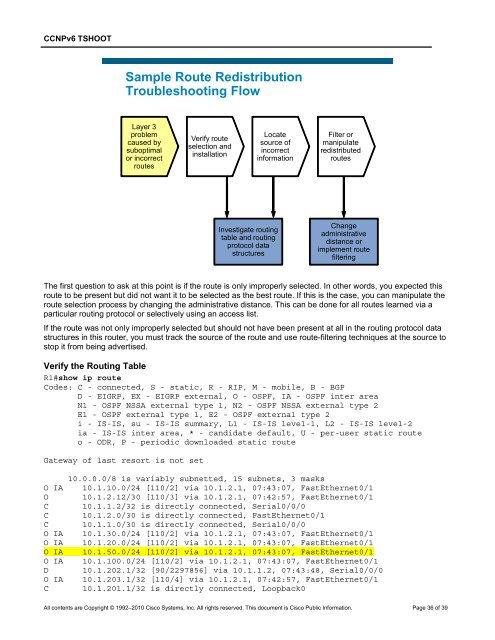CCNP TSHOOT 6.0 - Cisco Learning Home
CCNP TSHOOT 6.0 - Cisco Learning Home
CCNP TSHOOT 6.0 - Cisco Learning Home
You also want an ePaper? Increase the reach of your titles
YUMPU automatically turns print PDFs into web optimized ePapers that Google loves.
<strong>CCNP</strong>v6 <strong>TSHOOT</strong><br />
Sample Route Redistribution<br />
Troubleshooting Flow<br />
Layer 3<br />
problem<br />
caused by<br />
suboptimal<br />
or incorrect<br />
routes<br />
Verify route<br />
selection and<br />
installation<br />
Locate<br />
source of<br />
incorrect<br />
information<br />
Investigate routing<br />
table and routing<br />
protocol data<br />
structures<br />
Filter or<br />
manipulate<br />
redistributed<br />
routes<br />
Change<br />
administrative<br />
distance or<br />
implement route<br />
filtering<br />
© 2009 <strong>Cisco</strong> Systems, Inc. All rights reserved. <strong>TSHOOT</strong> v1.0—89<br />
The first question to ask at this point is if the route is only improperly selected. In other words, you expected this<br />
route to be present but did not want it to be selected as the best route. If this is the case, you can manipulate the<br />
route selection process by changing the administrative distance. This can be done for all routes learned via a<br />
particular routing protocol or selectively using an access list.<br />
If the route was not only improperly selected but should not have been present at all in the routing protocol data<br />
structures in this router, you must track the source of the route and use route-filtering techniques at the source to<br />
stop it from being advertised.<br />
Verify the Routing Table<br />
R1#show ip route<br />
Codes: C - connected, S - static, R - RIP, M - mobile, B - BGP<br />
D - EIGRP, EX - EIGRP external, O - OSPF, IA - OSPF inter area<br />
N1 - OSPF NSSA external type 1, N2 - OSPF NSSA external type 2<br />
E1 - OSPF external type 1, E2 - OSPF external type 2<br />
i - IS-IS, su - IS-IS summary, L1 - IS-IS level-1, L2 - IS-IS level-2<br />
ia - IS-IS inter area, * - candidate default, U - per-user static route<br />
o - ODR, P - periodic downloaded static route<br />
Gateway of last resort is not set<br />
10.0.0.0/8 is variably subnetted, 15 subnets, 3 masks<br />
O IA 10.1.10.0/24 [110/2] via 10.1.2.1, 07:43:07, FastEthernet0/1<br />
O 10.1.2.12/30 [110/3] via 10.1.2.1, 07:42:57, FastEthernet0/1<br />
C 10.1.1.2/32 is directly connected, Serial0/0/0<br />
C 10.1.2.0/30 is directly connected, FastEthernet0/1<br />
C 10.1.1.0/30 is directly connected, Serial0/0/0<br />
O IA 10.1.30.0/24 [110/2] via 10.1.2.1, 07:43:07, FastEthernet0/1<br />
O IA 10.1.20.0/24 [110/2] via 10.1.2.1, 07:43:07, FastEthernet0/1<br />
O IA 10.1.50.0/24 [110/2] via 10.1.2.1, 07:43:07, FastEthernet0/1<br />
O IA 10.1.100.0/24 [110/2] via 10.1.2.1, 07:43:07, FastEthernet0/1<br />
D 10.1.202.1/32 [90/2297856] via 10.1.1.2, 07:43:48, Serial0/0/0<br />
O IA 10.1.203.1/32 [110/4] via 10.1.2.1, 07:42:57, FastEthernet0/1<br />
C 10.1.201.1/32 is directly connected, Loopback0<br />
All contents are Copyright © 1992–2010 <strong>Cisco</strong> Systems, Inc. All rights reserved. This document is <strong>Cisco</strong> Public Information. Page 36 of 39
















